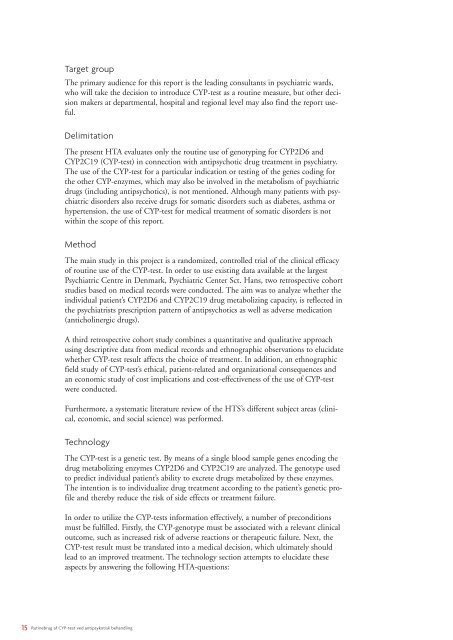Rapport: Rutinebrug af CYP-test ved antipsykotisk behandling
Rapport: Rutinebrug af CYP-test ved antipsykotisk behandling
Rapport: Rutinebrug af CYP-test ved antipsykotisk behandling
You also want an ePaper? Increase the reach of your titles
YUMPU automatically turns print PDFs into web optimized ePapers that Google loves.
Target groupThe primary audience for this report is the leading consultants in psychiatric wards,who will take the decision to introduce <strong>CYP</strong>-<strong>test</strong> as a routine measure, but other decisionmakers at departmental, hospital and regional level may also find the report useful.DelimitationThe present HTA evaluates only the routine use of genotyping for <strong>CYP</strong>2D6 and<strong>CYP</strong>2C19 (<strong>CYP</strong>-<strong>test</strong>) in connection with antipsychotic drug treatment in psychiatry.The use of the <strong>CYP</strong>-<strong>test</strong> for a particular indication or <strong>test</strong>ing of the genes coding forthe other <strong>CYP</strong>-enzymes, which may also be invol<strong>ved</strong> in the metabolism of psychiatricdrugs (including antipsychotics), is not mentioned. Although many patients with psychiatricdisorders also receive drugs for somatic disorders such as diabetes, asthma orhypertension, the use of <strong>CYP</strong>-<strong>test</strong> for medical treatment of somatic disorders is notwithin the scope of this report.MethodThe main study in this project is a randomized, controlled trial of the clinical efficacyof routine use of the <strong>CYP</strong>-<strong>test</strong>. In order to use existing data available at the largestPsychiatric Centre in Denmark, Psychiatric Center Sct. Hans, two retrospective cohortstudies based on medical records were conducted. The aim was to analyze whether theindividual patient’s <strong>CYP</strong>2D6 and <strong>CYP</strong>2C19 drug metabolizing capacity, is reflected inthe psychiatrists prescription pattern of antipsychotics as well as adverse medication(anticholinergic drugs).A third retrospective cohort study combines a quantitative and qualitative approachusing descriptive data from medical records and ethnographic observations to elucidatewhether <strong>CYP</strong>-<strong>test</strong> result <strong>af</strong>fects the choice of treatment. In addition, an ethnographicfield study of <strong>CYP</strong>-<strong>test</strong>’s ethical, patient-related and organizational consequences andan economic study of cost implications and cost-effectiveness of the use of <strong>CYP</strong>-<strong>test</strong>were conducted.Furthermore, a systematic literature review of the HTS’s different subject areas (clinical,economic, and social science) was performed.TechnologyThe <strong>CYP</strong>-<strong>test</strong> is a genetic <strong>test</strong>. By means of a single blood sample genes encoding thedrug metabolizing enzymes <strong>CYP</strong>2D6 and <strong>CYP</strong>2C19 are analyzed. The genotype usedto predict individual patient’s ability to excrete drugs metabolized by these enzymes.The intention is to individualize drug treatment according to the patient’s genetic profileand thereby reduce the risk of side effects or treatment failure.In order to utilize the <strong>CYP</strong>-<strong>test</strong>s information effectively, a number of preconditionsmust be fulfilled. Firstly, the <strong>CYP</strong>-genotype must be associated with a relevant clinicaloutcome, such as increased risk of adverse reactions or therapeutic failure. Next, the<strong>CYP</strong>-<strong>test</strong> result must be translated into a medical decision, which ultimately shouldlead to an impro<strong>ved</strong> treatment. The technology section attempts to elucidate theseaspects by answering the following HTA-questions:15 <strong>Rutinebrug</strong> <strong>af</strong> <strong>CYP</strong>-<strong>test</strong> <strong>ved</strong> <strong>antipsykotisk</strong> <strong>behandling</strong>
















